Forbidden Island - A review about global destruction.
 Wednesday, June 1, 2011 at 07:08PM
Wednesday, June 1, 2011 at 07:08PM 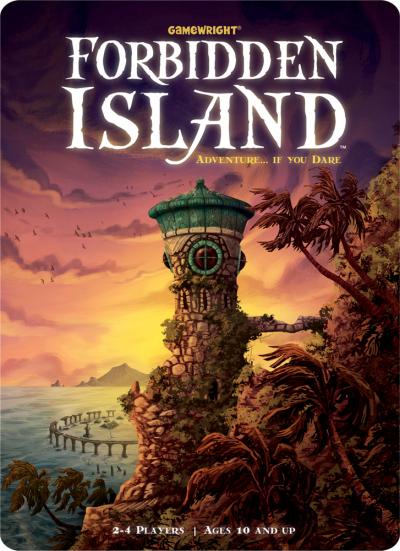
Long ago, four artifacts of immense power were hidden from prying eyes by the wise protectors of a long dead civilization known as the Archeans. This ancient civilization was the keeper of an unimaginable elemental power. A power harnessed through the use of the four treasures: The Crystal of Fire, The Statue of the Wind, The Ocean’s Chalice, and The Earth Stone. Fearing the catastrophic danger that misuse would create, the Archeans housed these dangerous relics on a secluded island, with an elaborate trap that would destroy the treasure, along with the island itself, were it to fall into foreign hands.
The Archaen civilization collapsed, and faded into obscurity long ago, but the Forbidden Island has waited silently, shrouding its wondrous secret, and biding its time until discovery wakes it and starts the deadly machinations that will send it to the ocean floor. That’s where you come in - as a brave explorer, you must retrieve the artifacts from the island, and escape with your life, before the island sinks into oblivion.
Forbidden Island is a cooperative family game designed by Matt Leacock and published by Gamewright Games. Similar in mechanics to Leacock’s lauded game Pandemic, Forbidden Island looks to transform the horrific prospect of global disaster found in Pandemic, into a family game of treasure hunting – with the horrific prospect of global disaster.
The part where the review takes a detour:
“What?! Global disaster?! You're crazy!” I hear you say, “Forbidden Island is just an exciting family game of treasure hunting”. I do not deny any mental instability on my part, but hear me out: Forbidden Island may have more sinister parallels to modern day issues, and pose more questions about ethics than is outwardly apparent. I’m sure that players start a game of Forbidden Island with heroic intentions, and honestly, will probably gloss over the theme. But playing the game bears the question, “Why unearth these artifacts?” Is it for Money? Power? History? Science? Wouldn’t it be better to leave these treasures in the ground?
Let’s forget about global disaster for a moment, and think about the moral implications of the players’ actions. By taking the treasure, the players are destroying an entire island full of ruins from an unknown civilization. By the time the players have left the island, the entire place is destroyed, with any archeological insight swallowed by the waves. This fact alone poses a lot of interesting questions about the players' intentions. By destroying so much unlearned history, the players can’t possibly be working under the banner of history or science. Given this insight, it means our intrepid explorers are robbing the island for either greed or power. This is probably not the light that players put themselves in when experiencing the game, but it makes for an interesting moral dilemma.
The sinister repercussions of the players’ actions don’t stop at the morality of historical conservation, either. The theme and background story of Forbidden Island describe the artifacts, which the players are risking their lives to acquire, as dangerous and catastrophic in the wrong hands. If the players’ motivation is money, then selling these artifacts to the highest bidder could have disastrous consequences for the world. If the motivation is power, then the players themselves will be unleashing an unknown element unto the world. Either way, the outlook is bleak for humanity. Perhaps Forbidden Island is but a prequel to Pandemic - the four virulent diseases unleashed on the world spawned from the four artifacts of the Forbidden Island.
Most likely, the explorers just don’t know what they are dealing with. After all, the Archaen civilization is long dead, and forgotten. How could the players possibly know of the dangers they unearth? The players can be comfortable knowing that their actions are not unsavory, as they are unaware of the nature of the island and its contents. This is the most sinister prospect of the game, because it hints at a possibility for our own future.
While the human race does not control the elements of ancient alchemy, we do control the seed of the scientific elements: the almighty atom. Through decades of nuclear proliferation and disposal, the human race has created its own artifacts of catastrophic power, locked away deep underground in military facilities peppering many “Forbidden Islands” across the globe. Like so many forgotten minefields from wars past, when our civilization is dust, will the things that we leave behind hold the power to destroy the unaware?
While I doubt that the story behind Forbidden Island was meant as a treatise on nuclear proliferation, that a paragraph of text on the first page of a game manual can elicit so many questions and thoughts about human nature says a lot about the prospect of board games as art. Many people, even some who support the board game hobby, insist that games cannot be art due to the core nature of games as a set of rules.
While games are a collection of rules at their core, when theme is added, they gain an aspect that even traditional art lacks: The ability for the player to experience moral and ethical dissonance due to his own actions. Instead of passively experiencing a static work, games allow the player to make decisions, and witness the consequences of those decisions. The gravity of the decisions can vary from game to game, but often times there is a deeper meaning that can be gleaned from those choices. Games can be experienced on many different levels, and just like literature, there can be layers beneath the surface that are only visible to those who look for them, and maybe, like Forbidden Island, the treasures found hidden there can be catastrophic to the unopened mind, forever changing it to seek out the deeper meaning in everything.
The Game:
(ED: We apologize for the wild detour, and assure you that this review is now back on it's tracks, and the engineer in charge has been summarily fired.)
 In Forbidden Island, players take turns drawing cards, and traversing the island, working to collect sets of cards which allow them to claim treasures. As soon as the players take the first turn, the island starts sinking, and the players must manage the flooding to ensure that they do not drown, or become trapped. If the players can secure all 4 treasures, and make it back to the helicopter alive, they win. But, winning is harder than it sounds, as there is only one win condition, and multiple ways to lose.
In Forbidden Island, players take turns drawing cards, and traversing the island, working to collect sets of cards which allow them to claim treasures. As soon as the players take the first turn, the island starts sinking, and the players must manage the flooding to ensure that they do not drown, or become trapped. If the players can secure all 4 treasures, and make it back to the helicopter alive, they win. But, winning is harder than it sounds, as there is only one win condition, and multiple ways to lose.
Components:
The Box: Forbidden Island comes in a colorful tin box, with artwork that is evocative and vivid. Although I am not a huge fan of tin boxes, as they tend to dimple, and get damaged easily, I have to admit that this one looks very nice. The box contains a custom plastic insert that is built to perfectly fit the components.
The Cards: Cards are used to represent several things in Forbidden Island. Two decks are used throughout the game, one that contains “Flood cards” representing island sections that are sinking and one containing “Treasure Cards” which represent treasure clues and special items that the explorers can collect. There is also a set of cards that describes each adventurer and their special power. These cards are good quality, sturdy, and can easily withstand the demand of play in a family setting.
Island Tiles: The game board is made up of 24 thick, double sided island tiles which represent the different sections of the island that the adventurers can travel to. One side of the tile is illustrated in full color, and the other side in a blue monochrome. The artwork on the tiles is fantastic, and it really works to immerse players in the game.
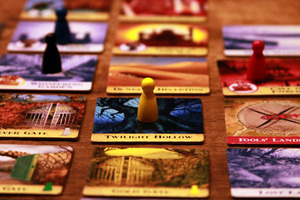 Player Pawns: The player pawns in the North American version of Forbidden Island are chunky colored wooden pawns, which are easy to manipulate. The German version of Forbidden Island has painted miniatures that represent the explorers, and while it would have been really nice to see them in the North American version, there is still plenty of bang for the buck for such a low price point.
Player Pawns: The player pawns in the North American version of Forbidden Island are chunky colored wooden pawns, which are easy to manipulate. The German version of Forbidden Island has painted miniatures that represent the explorers, and while it would have been really nice to see them in the North American version, there is still plenty of bang for the buck for such a low price point.
Treasure Figurines: These are the crown jewels of Forbidden Island. Each of the four treasures is represented with a detailed plastic figurine. These are hefty, and look really nice (especially the translucent fire treasure).
I am quite pleasantly surprised by the quality of the components in Forbidden Island. From the box itself, and its custom insert, to the wonderful components and molded figurines, it surpasses the quality found in many games that cost twice as much.
Setup:
The players start by laying out the 24 tiles that make up the island. The tiles are arranged face up, in a diamond-like shape, with some space between them to allow easy access to flip them when necessary. These 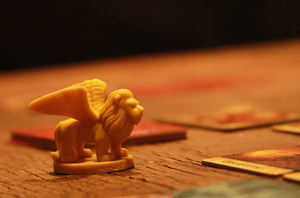 tiles make up the game board that the players will navigate. The treasure figurines are placed near the corners of the board, and the treasure and flood decks are then shuffled and placed within reach. The first six cards are drawn from the flood deck, and placed into the discard pile. The tile corresponding to each section depicted on a card is flipped over to show its blue, “flooded” side.
tiles make up the game board that the players will navigate. The treasure figurines are placed near the corners of the board, and the treasure and flood decks are then shuffled and placed within reach. The first six cards are drawn from the flood deck, and placed into the discard pile. The tile corresponding to each section depicted on a card is flipped over to show its blue, “flooded” side.
Each player selects one of the six explorer cards, and puts the corresponding colored pawn on the correct tile. Each explorer has a special power printed on his card that gives him a unique way that he can bend the rules.
After the each player has chosen an explorer, each player gets dealt two treasure cards. Finally, the water level indicator is moved to the desired difficulty number.
Gameplay:
Each turn in Forbidden Island is made up of three steps. Players alternate taking turns, with each player performing all three steps of each turn.
Step 1 – Actions:
Players may take up to 3 actions per turn. For each action, players can do one of four things: Move one space up, down, left, or right (some special abilities allow players to move in different ways); shore up an adjacent flooded tile (flipping it from the blue side, back to the colored side); Give a treasure card to a player in the same space as you; or claim a treasure if you are on a space with a treasure icon and you have 4 treasure cards that match the icon.
With 3 actions, and a limited number of things to do with each action, it may seem like the game is easy. Fortunately, the opposite is true. Every turn, the players will feel like they don’t have enough time to do what they want. Between moving, shoring up tiles, and trading cards with other players to collect 4 of a kind, there is a lot to be done with only 3 small actions, and if tiles sink in such a way to cause a player to become stranded, or a treasure to be lost to the sea, the game can end very suddenly.
Step 2 – Draw treasure Cards:
This step is both a blessing and a curse. Players draw two cards from the treasure deck. Most of these cards contain pictures of one of the four treasures, or some contain special actions that the players can take, but scattered throughout the deck are the dreaded “Waters Rise” cards. When one of these cards is drawn, the water level goes up one notch, and the discard pile from the flood deck is shuffled, and placed back on top of the flood deck.
Because the discard pile is NOT shuffled back into the deck, but instead placed on top of it, players will start to draw the same cards from the flood deck that they ha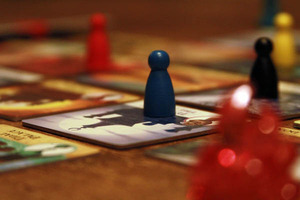 ve on previous rounds, increasing the chance that a flooded tile will be removed from the game completely. This drastically increases the amount of tension in the game. On top of this, as the water level increases, more and more cards are drawn from the flood deck during step 3, increasing the rate at which the island sinks.
ve on previous rounds, increasing the chance that a flooded tile will be removed from the game completely. This drastically increases the amount of tension in the game. On top of this, as the water level increases, more and more cards are drawn from the flood deck during step 3, increasing the rate at which the island sinks.
Step 3 – Draw Flood Cards:
The final step in a players turn is to draw flood cards. When a flood card is drawn, the corresponding tile is flipped onto its flooded side. If the tile is already on its flooded side, it is removed from the game completely, leaving a hole in the game board where players cannot move their pawns. The number of cards drawn is determined by looking at the current number on the water level indicator. As “waters rise” cards are drawn from the treasure deck, this number will increase.
Winning The game:
If the players can collect all 4 treasures, at least one player has a helicopter lift card, and they all make it back to the helicopter pad tile, they win the game. If any players drown, the helicopter pad sinks, there is no way to get a treasure because all of its corresponding tiles have been removed, or the water level reaches the skull and crossbones marker on the water level indicator, then the players lose.
Conclusion:
There is a lot of depth in Forbidden Island. While it doesn’t contain quite the level of complexity as its big brother Pandemic does, Forbidden Island concentrates the same feel into a simpler, more family friendly set of rules.
Players always feel like they are racing the clock as the tension in the game increases when “waters rise” cards start appearing, and the variable player powers add a bit of spice to the game, while still keeping it extremely app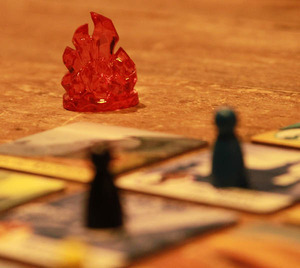 roachable. With a different combination of explorers each game, the player dynamic changes each time, and keeps the game fresh.
roachable. With a different combination of explorers each game, the player dynamic changes each time, and keeps the game fresh.
The underlying mechanic of the flood deck, and appearance of "waters rise" cards, revolves around randomness. But, it’s a controlled randomness that gives the game a bit of a press your luck feel, without seeming completely out of control. Players can make educated decisions based on the number of cards that have been drawn, and the probability of the next card.
I don’t have much negative to say about Forbidden Island, it works very well for my family and me. It is a cooperative game, though, and may suffer if you have people in your game group that like to take control, and tell others how to make their moves. Forbidden Island is not a super heavy game either, and thrives in a family setting. If you are looking for a deeper game with the same feel, I would suggest sticking with Pandemic.
If you are in need of a good family game, with rich and rewarding gameplay, and dramatic pacing that is right on the money, then Forbidden Island is for you. Its cooperative nature opens it up to many people who may be put off by the competitive nature of other games, by allowing the group to win or lose as a team, without hurt feelings or bruised egos. This is a game that is well deserving of its Spiel des Jahres nomination.
 Forbidden Island,
Forbidden Island,  Gamewright,
Gamewright,  Matt Leacock,
Matt Leacock,  review in
review in  Board Games
Board Games 
Reader Comments